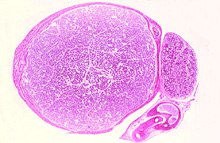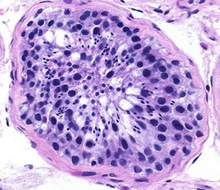 Testis
and spermatogenesis - Examine the preserved-mounted specimens of
testes and vas deferens, noting the macroscopic features (lobes,
tubules, etc.) for correlation with these structures on the slides. Testis
and spermatogenesis - Examine the preserved-mounted specimens of
testes and vas deferens, noting the macroscopic features (lobes,
tubules, etc.) for correlation with these structures on the slides.
Examine sections of the testis. Identify the capsule (tunica albuginea), interstitial tissue
or stroma, and the
seminiferous tubules .
Clinical note: Failure of the
testes to descend into the scrotum during fetal development
(cryptorchidism) maintains their temperature at 37 degrees C which inhibits
spermatogenesis, although testosterone production can still occur.
Excessive blood flow or dilated vasculature in the scrotum (varicocoele)
is another potential cause of male infertility and can be surgically
corrected.
Study a schematic diagram of spermatogenesis and its relationship to the sustentacular
Sertoli cells. In a tubule cut transversely, identify
myoid cells, Sertoli cells (with nucleoli),
spermatogonia, and the large primary spermatocytes. The
smaller secondary spermatocytes are much more short-lived and
therefore more difficult to find. (Do not spend time looking for
these.) Identify spermatids and differentiating spermatozoa. Try to
distinguish some of the morphological stages and changes that occur
in the differentiating spermatids during spermiogenesis.
Why are the secondary
spermatocytes rare?
What is the longest stage of spermatogenesis?
Indicate three functions of Sertoli cells.
Now for the vas
deferens and seminal vessicles.. |